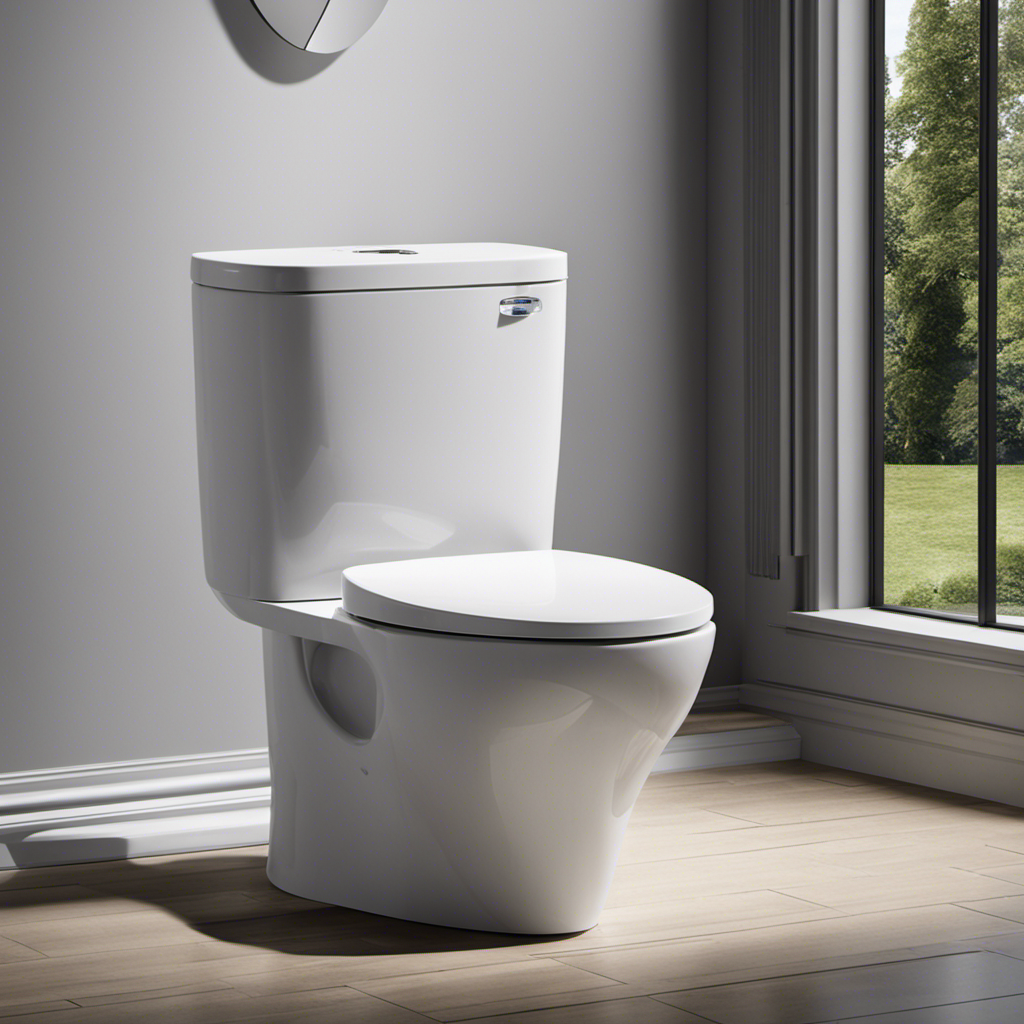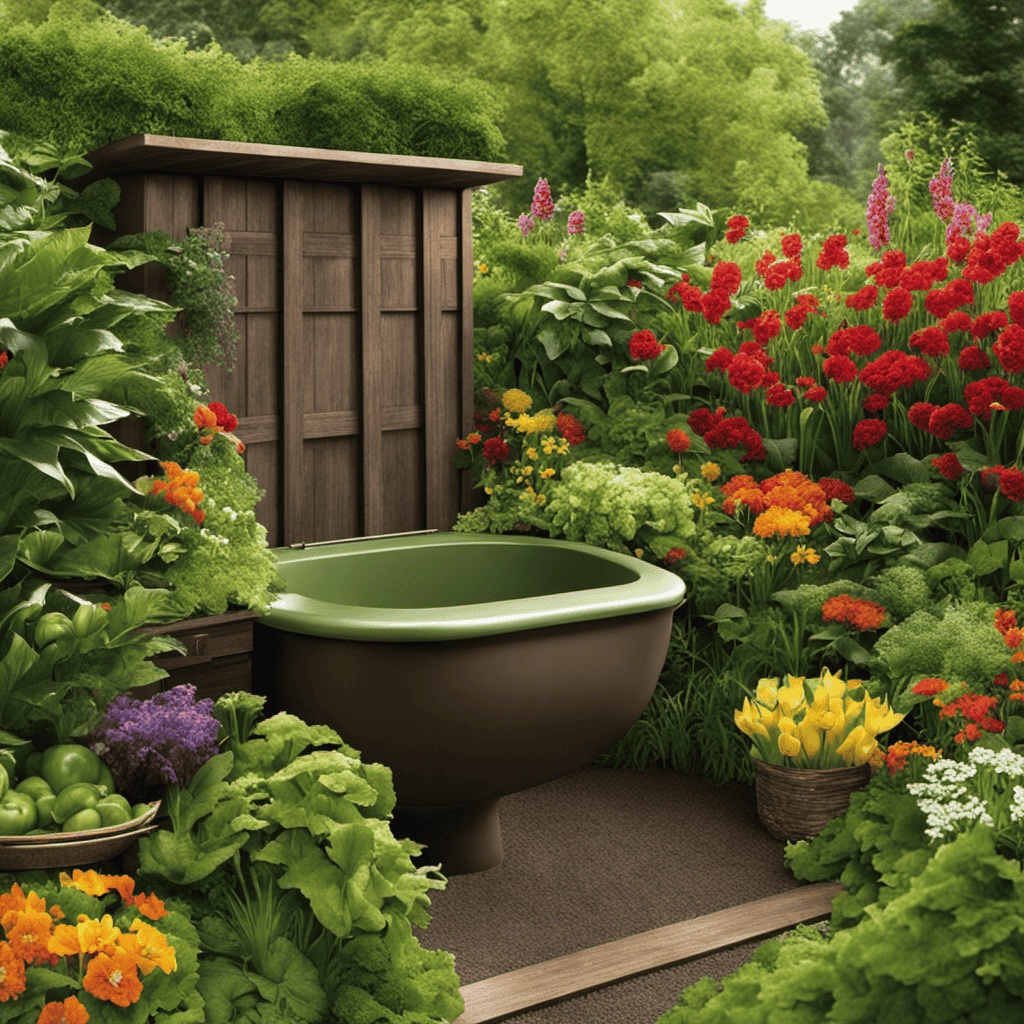Do you ever wonder how much water your toilet uses every time you flush?
Well, let’s dive into the world of toilet water consumption and find out!
In this article, we’ll explore the factors that affect water usage in toilets, from traditional flush mechanisms to water-saving innovations like low-flow and dual-flush toilets.
We’ll also provide you with practical tips to help you reduce water usage in your toilet.
Get ready to become a water-wise flusher!
Key Takeaways
- Older toilets use significantly more water per flush compared to newer models
- Upgrading to water-efficient toilets can save a substantial amount of water per year per household
- Toilet water-saving mechanisms such as dual flush and pressure-assist systems help reduce water consumption
- Flush volume regulations set standards for water usage in toilets and promote water conservation
Understanding Toilet Water Consumption
You might be wondering how much water your toilet uses per flush. Understanding toilet water consumption is essential in managing water usage and minimizing water bills.
On average, older toilets consume around 3.5 to 7 gallons of water per flush, while newer models use significantly less, ranging from 1.28 to 1.6 gallons. These statistics highlight the importance of upgrading to water-efficient toilets, as they can reduce water consumption by up to 20,000 gallons per year per household.
Factors Affecting Water Usage in Toilets
When it comes to conserving water in your toilet, there are several key factors to consider.
First, toilet water-saving mechanisms play a crucial role in reducing water consumption. These mechanisms include features such as dual flush systems, which allow for different water volumes depending on the type of waste being flushed.
Secondly, flush volume regulations set by government bodies ensure that toilets meet specific standards for water usage. These regulations dictate the maximum amount of water allowed per flush, helping to minimize water waste.
Lastly, there are various water-efficient toilet options available on the market. These toilets are designed to use less water per flush while still maintaining effective waste removal, making them an excellent choice for those looking to reduce their water footprint.
Toilet Water-Saving Mechanisms
Toilet water-saving mechanisms can significantly reduce the amount of water used per flush. These innovative toilet designs incorporate various features to promote toilet water conservation. Here are four examples of these mechanisms:
-
Dual-flush toilets: These toilets offer two flush options – a full flush for solid waste and a reduced flush for liquid waste. This allows you to choose the appropriate amount of water needed for each type of waste.
-
Pressure-assist toilets: These toilets use pressurized air to enhance flushing power, reducing the need for excessive amounts of water. They provide a forceful flush while using less water compared to traditional gravity-fed toilets.
-
Waterless urinals: These urinals eliminate the need for water altogether, using innovative technologies like gravity and specialized cartridges to dispose of urine without flushing. This saves significant amounts of water, particularly in high-traffic areas.
-
Dual-flush retrofit kits: These kits can be installed on existing toilets to transform them into dual-flush toilets. They offer a cost-effective solution for those looking to reduce water consumption without replacing their entire toilet.
By implementing these water-saving mechanisms, you can actively contribute to water conservation efforts while still maintaining optimal toilet functionality.
Now, let’s explore the next section on flush volume regulations.
Flush Volume Regulations
Flush volume regulations dictate the maximum amount of water that can be used during a single flush. These regulations have been put in place to promote water conservation efforts and reduce the overall water consumption associated with flushing toilets.
The flush volume guidelines vary depending on the location, but the most common regulation is a maximum of 1.6 gallons per flush (GPF). This means that when you press the flush button, the toilet tank will release a maximum of 1.6 gallons of water to clean and evacuate the bowl.
Water-Efficient Toilet Options
If you’re looking for an eco-friendly option, consider water-efficient toilets that can help reduce your environmental impact. These water-saving toilet designs are not only good for the planet, but they can also save you money on your water bill.
Here are four key features of these eco-friendly bathroom fixtures:
-
Dual-flush mechanism: Water-efficient toilets often have a dual-flush feature, allowing you to choose between a lower flush for liquid waste and a higher flush for solid waste. This way, you can minimize water usage depending on your needs.
-
Low-flow technology: These toilets are equipped with low-flow technology, which means they use less water per flush compared to traditional toilets. Some models can use as little as 1.28 gallons per flush (GPF), significantly reducing water consumption.
-
Pressure-assisted flushing: Water-efficient toilets may use pressure-assisted flushing, where water is forced into the bowl with more force, resulting in efficient waste removal and less water usage.
-
WaterSense certification: Look for toilets that are WaterSense certified, a program by the Environmental Protection Agency (EPA) that ensures water efficiency. These certified toilets meet strict criteria for performance and water efficiency.
By opting for water-efficient toilets, you can contribute to water conservation efforts and reduce your environmental footprint.
Now let’s explore the traditional toilet flush mechanisms and water usage.
Traditional Toilet Flush Mechanisms and Water Usage
When it comes to modern toilet efficiency and water-saving flush options, there are several key points to consider.
Firstly, modern toilets are designed to use less water per flush compared to traditional models. This is achieved through the use of innovative flush mechanisms that optimize water flow while still maintaining effective waste removal.
Additionally, there are now various water-saving flush options available, such as dual-flush toilets that allow you to choose between a full flush for solid waste and a reduced flush for liquid waste, further reducing water consumption.
Modern Toilet Efficiency
Toilets these days use much less water than they did in the past, so you don’t have to worry about wasting too much water with each flush. Thanks to innovative toilet designs, water conservation has become a primary focus in the development of modern toilets. Here are four key features that contribute to the efficiency of these toilets:
-
Dual-flush mechanism: Many modern toilets offer a dual-flush option, allowing you to choose between a partial flush for liquid waste and a full flush for solid waste. This reduces water usage for lighter loads.
-
Low-flow technology: Modern toilets are equipped with low-flow systems that optimize water usage without compromising performance. These systems use gravity and pressure to efficiently clear waste with minimal water.
-
Toilet tank design: Innovations in toilet tank design have resulted in smaller tank sizes. This means less water is required to fill the tank, leading to reduced water consumption per flush.
-
Water-saving features: Some toilets come with additional water-saving features, such as adjustable flush settings and leak detection systems. These features help further minimize water wastage.
With these advancements, modern toilets have significantly reduced water consumption, making them an environmentally-friendly choice for your bathroom.
Water-Saving Flush Options
The availability of dual-flush mechanisms in modern toilets allows you to choose between partial and full flush options, conserving water with each use. These water-saving toilet designs offer significant benefits in terms of water efficiency.
Traditional toilets typically use around 1.6 gallons of water per flush, which can quickly add up to a significant amount of wasted water. In contrast, dual-flush toilets give you the flexibility to use less water for liquid waste and more water for solid waste. The partial flush option uses approximately 0.8 gallons, while the full flush option uses around 1.6 gallons, still significantly less than a traditional toilet.
Low-Flow Toilets: How They Save Water
You can save water by using low-flow toilets, which are designed to use less water per flush. These toilets have several benefits and utilize water-saving toilet technology:
-
Reduced water consumption: Low-flow toilets typically use 1.6 gallons of water per flush, compared to older models that use 3-7 gallons. This significant reduction in water usage helps conserve water resources.
-
Cost savings: By using less water, low-flow toilets can help you save on your water bill. Over time, the savings can add up, making it a cost-effective option.
-
Environmental impact: By conserving water, low-flow toilets contribute to water conservation efforts and reduce strain on water sources. This helps protect the environment and ensures a sustainable future.
-
Government incentives: Many governments offer incentives, such as tax credits or rebates, for installing low-flow toilets. Taking advantage of these programs can further increase your savings.
By incorporating low-flow toilets in your home, you can contribute to water conservation efforts, save money, and reduce your environmental impact.
Now, let’s explore the benefits of dual-flush toilets for maximizing water efficiency.
Dual-Flush Toilets: Maximizing Water Efficiency
Now that you understand how low-flow toilets save water, let’s explore the benefits of dual-flush toilets and the installation process.
Dual-flush toilets offer even greater water efficiency by giving you the option to choose between a low-volume flush for liquids and a higher-volume flush for solids. This innovative design allows you to use only the necessary amount of water, reducing water consumption and saving money on your water bills.
When it comes to installation, converting to a dual-flush toilet is a straightforward process that can be done by a professional plumber or as a DIY project. You will need to remove the old toilet, install the dual-flush mechanism, and connect the water supply. Dual-flush conversion kits are readily available and come with detailed instructions to guide you through the installation process.
Tips for Reducing Water Usage in Toilets
Installing a dual-flush toilet can help conserve water and lower your water bill. Here are some toilet water saving hacks and eco-friendly toilet options that can further reduce your water usage:
-
Adjust the flush volume: Most toilets have an adjustable flush volume feature. By reducing the flush volume, you can save significant amounts of water with each flush.
-
Install a toilet tank bag: A toilet tank bag filled with water displaces some of the water in the tank, reducing the amount of water used for each flush.
-
Use a dual-flush retrofit kit: If you already have a standard toilet, you can convert it into a dual-flush toilet by installing a retrofit kit. This allows you to choose between a full flush for solid waste and a half flush for liquid waste.
-
Consider composting toilets: Composting toilets are a highly eco-friendly option that uses little to no water. These toilets break down waste into compost, which can be used as fertilizer.
Conclusion
Congratulations! You’ve gained a deep understanding of toilet water consumption and the various factors that affect it. From traditional flush mechanisms to low-flow and dual-flush toilets, you’ve learned how these innovations maximize water efficiency.
By implementing these tips for reducing water usage in toilets, you can contribute to water conservation efforts and create a more sustainable future.
So, next time you flush, picture a stream of water flowing effortlessly, knowing that you’re doing your part to protect our precious water resources.
Keep up the great work!










